NOVEMBER 8, 2020
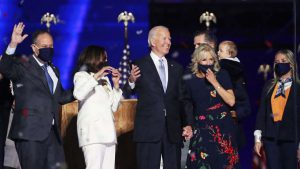
Joseph R. Biden Jr. ran as a determined pragmatist, believing that his party would embrace him as its best chance to beat President Trump. – Amr Alfiky/NY Times
On a January evening in 2019, Joseph R. Biden Jr. placed a call to the mayor of Los Angeles, Eric Garcetti, a personal friend and political ally who had just announced he would not pursue the Democratic nomination for president.
During their conversation, Mr. Garcetti recalled, Mr. Biden did not exactly say he had decided to mount his own campaign. The former vice president confided that if he did run, he expected President Trump to “come after my family” in an “ugly” election.
But Mr. Biden also said he felt pulled by a sense of moral duty.
“He said, back then, ‘I really am concerned about the soul of this country,’” Mr. Garcetti said.
Twenty-one months and a week later, Mr. Biden stands triumphant in a campaign he waged on just those terms: as a patriotic crusade to reclaim the American government from a president he considered a poisonous figure. The language he used in that call with Mr. Garcetti became the watchwords of a candidacy designed to marshal a broad coalition of voters against Mr. Trump and his reactionary politics.
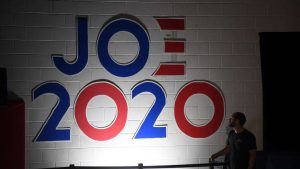
Mr. Biden at times faced doubts about his political acuity and the relevance, in the year 2020, of a set of union-hall-meets-cloakroom political instincts developed mainly in the previous century. – Courtland Wells/NY Times
It was not the most inspirational campaign in recent times, nor the most daring, nor the most agile. His candidacy did not stir an Obama-like youth movement or a Trump-like cult of personality: There were no prominent reports of Biden supporters branding themselves with “Joe” tattoos and lionizing him in florid murals — or even holding boat parades in his honor. Mr. Biden campaigned as a sober and conventional presence, rather than as an uplifting herald of change. For much of the general election, his candidacy was not an exercise in vigorous creativity, but rather a case study in discipline and restraint.
In the end, voters did what Mr. Biden asked of them and not much more: They repudiated Mr. Trump, while offering few other rewards to Mr. Biden’s party. And by a popular vote margin of four million and counting, Americans made Mr. Biden only the third man since the Second World War to topple a duly elected president after just one term.
Throughout his campaign, Mr. Biden faced persistent doubts about his political acuity and the relevance, in the year 2020, of a set of union-hall-meets-cloakroom political instincts developed mainly in the previous century.
But if Mr. Biden made numerous errors along the way, none of them mattered more in this election than the essential rightness of how he judged the character of his party, his country and his opponent. This account of his candidacy, based on interviews with four dozen advisers, supporters, elected officials and friends, reveals how fully Mr. Biden’s campaign flowed from his own worldview and political intuition.
During the primaries, Mr. Biden rebuffed pressure to move to the left, believing his party would embrace his pragmatism as its best chance to beat Mr. Trump. In the general election, Mr. Biden made Mr. Trump’s erratic conduct and mismanagement of the coronavirus pandemic his overwhelming themes, shunning countless other issues as needless distractions.

Mr. Biden abstained from in-person campaign events for months to avoid undermining public-health guidelines or risking infection himself. He returned in the summer with small, socially distanced stops. – Mark Makela/NY Times
While some Democrats urged him to compete in a wider array of battlegrounds, Mr. Biden put the Great Lakes states at the center of his electoral map, trusting that with an appeal to the political middle he could rebuild the so-called Blue Wall and block Mr. Trump’s path to a second term.
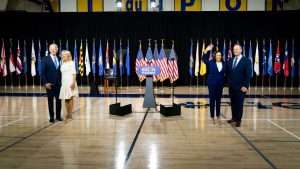
Mr. Biden selected Senator Kamala Harris of California, a one-time rival for the presidential nomination, as his running mate in August. – Erin Schaff/NY Times
Perhaps most importantly, Mr. Biden believed that no issue would figure larger in voters’ minds than Mr. Trump’s presence in the Oval Office. And if he could make the election an up-or-down vote on an out-of-control president, he believed he could win.
On that score, he was right. As voters sized up Mr. Biden as a potential president, his familiar flaws and foibles — the antiquated vocabulary and penchant for embellishment, his nostalgic yarns about segregationist senators and a defensiveness that led him, in one case, to challenge a voter to a push-up contest — paled against the conduct of an incumbent sowing racial division, threatening to deploy troops in American cities and floating the idea of injecting disinfectant as a coronavirus treatment.
Anita Dunn, one of Mr. Biden’s closest advisers, said the campaign had been propelled all along by the candidate himself, and his unwavering theme and strategy.
“It was his campaign,” Ms. Dunn said. “It was less consultant-driven than any presidential campaign in modern history.”
Still, at the outset, Mr. Biden’s political theory of the case struck even some of his loyal allies as misguided in an era of intense ideological polarization.
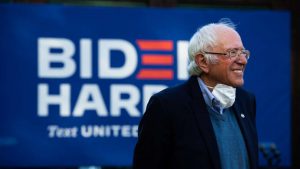
When Senator Bernie Sanders of Vermont withdrew from the race, Mr. Biden agreed to form a set of policy task forces to formulate a shared governing agenda. – Elizabeth Frantz/NY Times
Senator Bob Casey of Pennsylvania recalled a meeting he had with the former vice president in March of 2019, shortly before Mr. Biden entered the race. As Mr. Biden sketched out his approach, Mr. Casey, a Democrat, was not fully convinced.
“He was walking through what became his broader-based theme, about the soul of the country,” Mr. Casey said. “I was worried at the time that it wasn’t hard-hitting enough.”
But Mr. Biden, he said, “was prescient in his ability, even in the primaries when almost nobody else was doing it, to say, ‘We have to bring the country back together.’”
A Crisis Candidacy
Mr. Casey was not the only Democrat skeptical of Mr. Biden’s underlying theme. While many voters found Mr. Trump distasteful, or worse, it is difficult to unseat an incumbent president and Mr. Trump had the benefit of a nation in relative peace and steady prosperity. Mr. Biden’s primary opponents, who argued that a message of normalcy and steady experience might not be enough to win, seemed to have a point.
Then, just as Mr. Biden was seizing a clear upper hand in the Democratic nomination fight, the coronavirus pandemic struck. In a matter of days, public campaigning froze and a mood of fear and gloom set in across the country.
Gov. Gretchen Whitmer of Michigan, a close ally of Mr. Biden, said it was not immediately obvious that the Trump administration would effectively forfeit the issue of public health to Mr. Biden. The White House, Ms. Whitmer said, “really could have risen to the occasion.”
But as Mr. Trump dismissed the threat of the pandemic, and railed against governors like Ms. Whitmer for locking down their states, Mr. Biden moved to assert himself as an alternative leader. He began to sketch his own approach to addressing the disease, and to show voters how he might operate in Mr. Trump’s place.

Protests erupted after the police shot Jacob Blake, a Black man, multiple times in the back in Kenosha, Wis. – Alyssa Schukar/NY Times
From the confines of his lakeside home in Wilmington, Del., he received frequent briefings about the pandemic and the economic damage it was inflicting, drafted policy plans and reached out to state and city leaders to gather information.
“He was calling to say, ‘How are things going in Michigan? What do you need?’” Ms. Whitmer said.
What Mr. Biden was not doing, to the dismay of some in his party, was traveling the country and campaigning in person. For months, he scarcely left the immediate vicinity of his home: At 77, he was in an age group especially vulnerable to the virus, and his advisers felt he could undermine his own public-health recommendations if he was seen as racing back onto the campaign trail. And more than a few political donors and Democratic advocacy groups second-guessed the Biden campaign’s decision to forego a robust get-out-the-vote operation in the field because of safety concerns.
Marc Morial, president of the National Urban League, said Mr. Biden had seemed at first to pay a price for his caution. Allies of the Biden campaign had tried to nudge the former vice president into public view, he said, paraphrasing the plea: “People need to see you.”
But in his own conversations with the Biden team, Mr. Morial said, they were emphatic that Mr. Biden felt he could not “say one thing and do another” where public health was concerned — a judgment that Mr. Morial came to share.
Mr. Biden’s first major trip outside Delaware was not for a traditional campaign trip but to confront another crisis: the national reckoning over police brutality after the killing of George Floyd. Flying to Houston to visit the Floyd family, Mr. Biden sat for two hours as he listened to the grieving family and told them that while he had never experienced loss quite like theirs, he knew what it meant to lose a child and felt their pain, according to the Rev. Al Sharpton, who was present. When racial-justice protests turned disorderly in Atlanta, Mr. Biden reached out to the city’s mayor, Keisha Lance Bottoms, to offer support and private counsel. The former vice president, Ms. Bottoms said, was both encouraging and contemplative, telling her how the spiraling demonstrations evoked, for him, the riots in Wilmington in the late 1960s, which led to an extended occupation of the city by the National Guard.
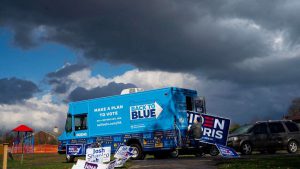
Mr. Biden focused on reclaiming states that Mr. Trump flipped in 2016, like Pennsylvania. – Ruth Fremson/NY Times
It was a study in the personal empathy, and the hunger to connect with other people, that defined Mr. Biden as a candidate from the start. Throughout the race he invoked his own family’s history of tragedy, and never more so than in confronting the immense pain and loss of the coronavirus pandemic.
“He is able to personalize these big issues,” Ms. Bottoms said. “He really does have a sensitivity and a personal lens for many of these challenges that we’re facing.”
Mr. Biden also recognized that his opponent lacked that impulse.
While Democrats worried that Mr. Biden was taking an overly passive approach to the race, Mr. Trump seemed almost to go out of his way to reinforce the appeal of his challenger’s prudence: There was Mr. Trump’s tear gas-shrouded photo op in Lafayette Park, intended as a show of strength, that came off instead as pure brutishness. There was his indoor rally in Tulsa, Okla., planned as an energetic return to the campaign trail, that instead became a low-energy coronavirus risk zone.
Still, as the country’s mood of emergency deepened, Mr. Biden confided to allies that he was already feeling the weight of the challenges that would lie ahead if he won.
Senator Tammy Duckworth of Illinois said she told Mr. Biden in a conversation earlier this year that the political moment seemed to cry out for a candidate with formidable governing experience. According to Ms. Duckworth’s recollection, Mr. Biden responded, “Tammy, I need people around me that understand that, and that we need to hit the ground running.”
Mr. Biden reacted in a similar fashion last Monday in Cleveland, when Senator Sherrod Brown of Ohio told Mr. Biden he would soon have the chance to be “one of the great presidents of my lifetime.”
“He grabbed my shoulder,” Mr. Brown said, “pulled me in as much as you can when you’re wearing a mask and said: ‘I really need you to help me.’”
Mr. Biden also expressed pointed anxiety after delivering a pair of speeches about national unity and healing at Gettysburg, Pa., and Warm Springs, Ga. — two landmarks associated with the crisis presidencies of Abraham Lincoln and Franklin Roosevelt.
If Mr. Biden found those backdrops politically resonant, he suggested to an adviser that he was less comfortable with the implied comparison between himself and those men. Mr. Biden had a difficult time, he said, seeing himself as the next Lincoln or Roosevelt.
Party Unity, of a Kind
The pandemic alone might not have shifted the political landscape in Mr. Biden’s favor had he not managed a feat the previous Democratic nominee, Hillary Clinton, could not: persuading Democrats to lock arms with him after a bruising primary.
Mr. Biden, however, had advantages that Mrs. Clinton did not, starting with a genial relationship with his chief opponent, Senator Bernie Sanders of Vermont.
As the Democratic contest neared its end, Mr. Biden quickly took steps to accommodate his former rivals on the left. Days after Senator Elizabeth Warren of Massachusetts ended her campaign in early March, Mr. Biden called to tell her he was adopting one of her key proposals on bankruptcy reform. And when Mr. Sanders withdrew from the race, Mr. Biden agreed to create a set of policy task forces to formulate a shared governing agenda.
Representative Kathy Castor of Florida, a Democrat who sat on Mr. Biden’s climate task force, said the difference from 2016 was stark: “That was just so divisive back then, from the Democratic convention in Philadelphia through the election,” she said. “You can’t have Democrats fighting Democrats.”
But Mr. Biden did not budge on the overall ideological thrust of his campaign. On the contrary, he and his close advisers felt vindicated in their assessment of the Democratic Party as a center-left coalition, rather than one of the activist left. Though he added a handful of progressive policy hands to his campaign staff, Mr. Biden’s inner circle was dominated by relative centrists for whom the Sanders ethos of democratic socialism held little appeal.
Perhaps most prominent among those advisers was Valerie Biden Owens, Mr. Biden’s sister and longtime counselor, who stressed during internal deliberations that the campaign should be careful about attacking the wealthy as a political tactic. After all, Ms. Owens argued, many working-class people aspire to be rich.
“The Democratic Party is not what people may think it is on Twitter,” said Representative Brendan Boyle of Pennsylvania, a Biden supporter from day one who recalled telling the former vice president as much last year. “It’s still working-class African-Americans, whites and Latinos. And he was always true to that.”
Over the summer, Mr. Biden chose a running mate who he hoped would reconcile the competing pressures on his candidacy: to excite his own party without creating new vulnerabilities that Republicans might be able to exploit. He settled on Senator Kamala Harris of California, completing his ticket with a choice that was at once groundbreaking and cautious — a younger woman of color who largely shared his own pragmatic political instincts.
He wound up with a message and policy agenda that left Mr. Trump with only limited avenues for attack, and benefited from the president’s lack of interest in learning details. When Mr. Trump sensed vulnerabilities in the Democratic platform, he never devised a critique deeper than one-liner jibes seemingly made for Fox News: His attacks on Mr. Biden’s climate plans, for instance, included claims that Democrats would force buildings to have tiny windows.
If Mr. Biden’s approach held up throughout the campaign, it left enormous unanswered questions for him to confront later on. In some cases, Mr. Biden and his advisers deliberately opted to suppress rather than resolve Democratic disagreements until after the election.
The most prominent example was Mr. Biden’s evasive response to Justice Amy Coney Barrett’s elevation to the Supreme Court. As other Democrats raised a cry of support for overhauling the federal judiciary, Mr. Biden spent weeks refusing to state his own position, eventually proposing a commission to study judicial reforms as a temporary salve.
The rush to seat Justice Barrett opened his eyes more to the hardball tactics of today’s Senate Republicans, said one adviser. But in private, Mr. Biden has continued to express unease about trying to expand the high court, and he is still more intrigued by broader judicial reforms than simply adding justices.
One lawmaker said Steve Ricchetti, a former chief of staff to Mr. Biden, had been candid last summer about the campaign’s dilatory approach to the party’s internal divisions. Asked privately how Mr. Biden intended to handle the left, Mr. Ricchetti acknowledged that it would be a challenge over the long term.
For the moment, he said, getting through Nov. 3 was the only goal.
The Blue Wall and the Blue Line
The most perilous moment of the race for Mr. Biden may have come in late August, when a season of racial-justice protests had given way to spasms of vandalism and arson in a handful of politically important states. In Wisconsin, after the shooting of Jacob Blake, a Black man, by a police officer in Kenosha, rioting erupted in the suburban city — and Mr. Trump went on the attack.
At the Republican nominating convention, the president and his allies pounded Mr. Biden for a week with false or overstated attacks, linking him both to outright criminals and to left-wing activists who had taken up “defund the police” as a slogan. Mr. Biden had disavowed the idea, but Republicans persisted.
The onslaught posed a distinctive challenge to Mr. Biden, threatening to weaken his coalition of racial minorities, young liberals and moderate whites. Mr. Trump began a scare campaign aimed in part at white women, telling them he would “save your suburbs” from what he portrayed as looting mobs that Mr. Biden would not control.
Like other liberals of his generation, Mr. Biden saw danger in the Kenosha riots. Recalling the riots in American cities after the assassinations of the 1960s, he telephoned an adviser, saying he wanted to denounce the violence and asking a question: What had Robert F. Kennedy said to cool tempers in the aftermath of the Rev. Dr. Martin Luther King Jr.’s murder?
Mr. Biden flew to Pittsburgh the following Monday to head off Mr. Trump’s attacks: In a 24-minute speech, he reaffirmed his support for police reform while sternly denouncing civil unrest. “Looting,” he said, “is not protesting.”
“We need justice in America. We need safety in America,” Mr. Biden said.
The Biden campaign turned a clip from the speech into a television ad and ran it at saturation levels across the electoral map, countering Mr. Trump’s claims that a Democratic administration would unleash violent anarchy.
“Joe has always been someone who was able to hold two thoughts together at the same time about law enforcement and racial justice,” said Senator Chris Coons of Delaware.
And once again, Mr. Biden benefited from his opponent’s impulse toward incitement and division. At the very moment Democrats feared voters might see Mr. Trump as a fearless steward of public safety, the president also spoke out in defense of people sowing chaos on the right.
Mr. Trump would do so again in his first debate with Mr. Biden, marring his law-and-order message by declining to denounce an extremist group on the far right.
Counting to 270
That moment after Kenosha was all the more important to Mr. Biden because of its resonance across the Midwest, the region he prized above all others. It was the band of states stretching from Minnesota across to Pennsylvania, Mr. Biden believed, that was likeliest to make him the next president.
His top lieutenants shared that assessment.
During a marathon Zoom session in May, after the campaign’s first major round of polling in the general election, Mr. Biden and his high command spent hours poring over the electoral map. By the end, they had hammered out their priorities: They would focus on three Great Lakes states Mr. Trump flipped in 2016 — Wisconsin, Michigan and Pennsylvania — plus Arizona, Florida and North Carolina. The campaign was skeptical of its chances in Florida and saw two other Sun Belt states, Georgia and Texas, as intriguing — but difficult and expensive to compete in.
When Mr. Biden and Ms. Harris returned to the campaign trail, that map guided their activities and their advertising strategy. They lunged at a few longer-shot targets, sending Ms. Harris on a last-minute trip to Texas, while Mr. Biden returned to Ohio, where polls showed him being competitive. Neither state wound up being close on election night.
More fruitful was an aggressive late play for Georgia, a rapidly diversifying state where suburban voters appeared to be swinging hard toward Democrats. In October, Mr. Biden’s pollster, John Anzalone, determined that the former vice president had a better chance to win there than in North Carolina and even Florida, and Mr. Biden embarked on his trip to Atlanta and Warm Springs. Ms. Harris visited the state repeatedly, and on the eve of the election the campaign decided to send former President Barack Obama to Georgia rather than North Carolina to make one last push there.
As the results began coming in on Tuesday, a tense mood took hold across much of the Biden campaign. In the first states to report, Florida and North Carolina, Mr. Trump was faring several points better than Democratic polling had forecast, and considerably ahead of most surveys conducted by the media.
The Biden campaign publicly projected composure, in contrast to Mr. Trump’s erratic behavior on Twitter and during late-night remarks from the East Room. Greg Schultz, Mr. Biden’s former campaign manager during the Democratic primaries, held a call with key supporters to offer reassurance, insisting that the early returns in the suburbs of Ohio were a good omen for the nearby swing states. But to some agitated listeners it was not a convincing presentation.
Mr. Biden’s inner circle grew increasingly unnerved as the night wore on and it became clear that the president was running stronger than expected. Jill Biden, former Senator Christopher Dodd of Connecticut and an array of Biden advisers telephoned Democrats around the country to learn more about the vote count and whether Mr. Biden was in danger of losing.
Within a matter of hours, Mr. Biden’s fortunes had improved as the big cities of the North reported their votes. It would take until Saturday, when Pennsylvania was called in his favor, to confirm that Mr. Biden had won more than the 270 Electoral College votes required to claim the presidency. The Blue Wall was standing again for Democrats, and Mr. Biden could also prevail in the once-red states of Arizona and Georgia.
For all the Democratic jubilation at Mr. Trump’s demise, Mr. Biden may not entirely share that feeling of pure delight. Rahm Emanuel, who served as Mr. Obama’s chief of staff during the Great Recession, said he warned Mr. Biden recently that his reward for winning would be fleeting.
“You’re the dog that caught the car,” Mr. Emanuel said, alluding to what awaited Mr. Biden in the Oval Office.
The man who would soon be president-elect responded: “Ain’t that the truth.”
Courtesy/Source: NY Times










































































































